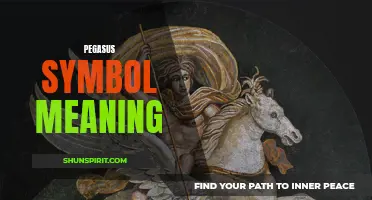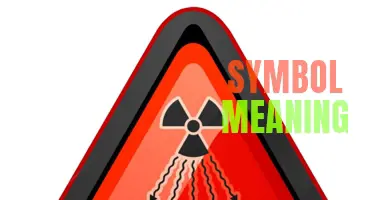
The crown is a powerful and iconic symbol that has held great significance throughout history. From ancient rulers to modern day monarchs, the crown represents authority, power, and majesty. It is a symbol of leadership and sovereignty, often adorned with precious gemstones and intricate designs. The crown also carries a sense of prestige and honor, signifying the wearer's elevated status and rightful position at the top. Beyond its literal meaning, the crown has also taken on a symbolic significance, representing the individual's inner strength, resilience, and ability to overcome challenges. Whether seen as a physical object or as a metaphorical concept, the crown continues to captivate our imagination and symbolize the essence of royalty and greatness.
What You'll Learn
- What is the symbolic meaning of a crown in various cultures and societies?
- How has the symbolic meaning of a crown evolved throughout history?
- What significance does a crown hold in monarchy and royal traditions?
- Does the symbolic meaning of a crown vary depending on its design or material?
- Are there any common themes or symbols associated with crowns in literature, art, or mythology?

What is the symbolic meaning of a crown in various cultures and societies?
The Crown: Symbolic Meaning in Various Cultures and Societies
Throughout history, the crown has been a symbol of power, authority, and sovereignty. It has been worn by kings and queens, emperors and empresses, and other leaders to signify their position and social status. But beyond its practical purpose, the crown also holds deep symbolic meaning in various cultures and societies.
In ancient Egypt, the crown represented the ruler's legitimacy and divine right to rule. The pharaohs wore the pschent, a combination of the red crown of Lower Egypt and the white crown of Upper Egypt, to symbolize their mastery over both regions. The Egyptian crown also featured the uraeus, a cobra symbolizing protection and divine authority.
In Ancient Greece, the crown symbolized victory and honor. Athenian athletes would receive a crown made of olive leaves at the Olympic Games, representing their athletic prowess and glory. The wreath crown, known as a laurel wreath, was also associated with Apollo, the Greek god of music, poetry, and prophecy.
In Christian symbolism, the crown represents righteousness and reward in the afterlife. The biblical concept of the crown of life represents the eternal life promised to believers. In Christian art, Jesus Christ is often depicted wearing a crown of thorns, symbolizing his suffering and sacrifice.
In medieval Europe, crowns were highly ornate and elaborate, adorned with precious gems and metals. The crown represented the monarch's descent from divine lineage and their authority to rule. The monarchy was seen as a sacred institution, and the crown served as a visual reminder of the ruler's important role in society.
In Japan, the crown holds a different meaning. The Imperial Crown of Japan, also known as the Three Sacred Treasures of Japan, consists of a sword, a mirror, and a jewel. These items have a mythological significance and are believed to have been passed down from the gods. The crown represents the emperor's position as the highest authority and the guardian of Japanese tradition and culture.
In modern society, the crown is often associated with beauty pageants and monarchy. Beauty queens wear crowns to symbolize their triumph and influence. The Miss Universe and Miss World competitions are prime examples of how the crown represents power, success, and beauty.
In conclusion, the symbolic meaning of the crown varies across different cultures and societies. It has represented power, authority, victory, righteousness, and divine favor throughout history. Whether worn by ancient rulers, Christian figures, or modern beauty queens, the crown continues to hold significance as a symbol of status and achievement.
The Power of Symbols: Exploring the Meanings Behind Symbols That Represent Growth
You may want to see also

How has the symbolic meaning of a crown evolved throughout history?
Throughout history, the crown has held significant symbolic meaning in various cultures around the world. It has been associated with royalty, power, authority, and divine right. The symbolic meaning of a crown has evolved over time, reflecting changes in social, political, and religious beliefs.
In ancient times, crowns were often worn by rulers as a symbol of their status and divine authority. In ancient Egypt, for example, the Pharaohs wore a crown called the "Nemes" as a symbol of their connection to the gods and their role as the ruler of the land. Similarly, in ancient Greece, the laurel wreath was worn by victorious athletes, symbolizing their achievement and status.
In medieval Europe, crowns took on a more elaborate and ornate design, reflecting the grandeur and power of the ruling monarch. The Christian Church played a significant role in shaping the symbolic meaning of crowns during this period. The Pope wore a tiara, a triple crown, symbolizing his authority as the head of the Catholic Church. Kings and queens were also crowned with elaborate crowns, often incorporating precious gems and symbols of their kingdom.
During the Renaissance, crowns became even more extravagant, adorned with jewels, pearls, and intricate designs. They symbolized not only the monarch's authority but also their wealth and opulence. The crown became a potent symbol of status and power, emphasizing the divine right of kings to rule.
In more recent history, the symbolic meaning of the crown has evolved further, reflecting changing societal values. With the rise of democratic systems of government, crowns lost their political significance and became more associated with ceremonial and symbolic roles. Monarchs no longer wielded absolute power, and the crown became a representation of national unity and tradition.
Today, many countries still have monarchies, and the crown continues to be a symbol of their monarchy's existence. However, the meaning of the crown has become more symbolic than authoritative. It represents tradition, continuity, and national identity. In some cultures, crowns are also worn by religious leaders or during special ceremonies, symbolizing spiritual authority and connection to the divine.
In conclusion, the symbolic meaning of a crown has evolved throughout history. From its origins as a symbol of divine right and power, the crown has transformed into a representation of tradition, national identity, and spiritual authority. While its political significance may have diminished, the crown's symbolism remains a powerful reminder of our collective history and the role of leadership in society.
The Hidden Meanings Behind the Pathfinder Symbol
You may want to see also

What significance does a crown hold in monarchy and royal traditions?
A crown is not just a beautiful piece of jewelry worn by monarchs; it holds a deep significance in monarchy and royal traditions. Throughout history, the crown has symbolized power, authority, and the divine right to rule.
One of the main purposes of a crown is to visibly identify the monarch as the ruler. The crown is typically adorned with precious jewels, diamonds, and pearls, making it a stunning display of wealth and status. By wearing the crown, the monarch stands out from the rest of the people and is instantly recognizable as the person in charge.
In addition to its visual significance, the crown also represents the divine right to rule. In many monarchies, the ruler is believed to have been chosen by a higher power, such as God or the gods. The crown, often designed with religious symbols or motifs, serves as a testament to the ruler's connection to the divine. It is a tangible representation of their legitimacy and their role as the chosen leader.
The crowning ceremony itself is a significant event in royal traditions. It is a sacred ritual where the monarch is anointed and crowned, signifying their sacred authority. The ceremony often involves religious leaders and is attended by members of the royal family and distinguished guests. The act of crowning marks the official beginning of the monarch's reign and their acceptance of the responsibilities and duties that come with the position.
Throughout history, crowns have also been associated with the concept of monarchy and the continuity of power. In many monarchies, the crown is passed down from one generation to the next, reinforcing the idea of dynastic rule. This tradition helps maintain stability and continuity within the monarchy, as well as a sense of identity and tradition for the nation.
Beyond its symbolic meaning, the crown also plays a practical role in royal traditions. It serves as a reminder to the monarch of their duties and responsibilities. It is often worn during official ceremonies, state visits, and other important events, serving as a visual reminder of the ruler's authority and position.
In conclusion, the crown holds great significance in monarchy and royal traditions. It symbolizes power, authority, and the divine right to rule. The crown visually identifies the monarch as the ruler and serves as a tangible representation of their legitimacy. The crowning ceremony is a sacred ritual that marks the beginning of their reign. Furthermore, the crown represents the continuity of power and serves as a reminder to the monarch of their duties and responsibilities.
The Hidden Symbolism and Deep Meaning Behind the Cobra
You may want to see also

Does the symbolic meaning of a crown vary depending on its design or material?
Symbolism of a Crown: Design and Material's Role
A crown is a powerful symbol that has been used throughout history to signify status, power, and authority. Whether it is worn by royalty, religious figures, or even in modern-day events like beauty pageants, the crown holds a significant symbolic meaning. However, does this meaning change depending on its design or material? Let's explore how these factors can shape the symbolism of a crown.
Design plays a crucial role in the symbolic meaning of a crown. Each design element can convey different attributes and associations. For example, a crown with sharp, jagged points may represent a fierce and intimidating authority. On the other hand, a crown with soft curves and gentle embellishments may symbolize a more nurturing and compassionate form of leadership. The choice of gemstones, engravings, and other ornate details can also enhance the symbolism of the crown. For instance, diamonds, rubies, and other precious stones can signify wealth, while intricate engravings can reflect a rich history or cultural significance.
Moreover, the material from which a crown is made also influences its symbolic meaning. Historically, crowns have been crafted from various materials, including gold, silver, and precious gemstones. Gold, with its inherent value and rarity, has often been associated with divine or royal power. Its lustrous appearance represents opulence and wealth. Conversely, silver is often linked to purity and wisdom. Some crowns may even incorporate precious gemstones, each with their own symbolic meanings. For instance, diamonds can represent strength and resilience, while sapphires might signify loyalty and truth.
In addition to precious metals and gemstones, other materials can be used to create crowns. For example, a crown made from leaves or branches carries symbolism related to nature and connection with the land. This type of crown might be worn by a leader with an environmental or conservationist focus. Another example is a crown made from feathers, which can represent spiritual or tribal connections, often seen in indigenous cultures.
Cultural context also plays a vital role in interpreting the symbolism of a crown. Different cultures have their own unique meanings attached to crowns. In some civilizations, such as ancient Egypt, the crown symbolized divine authority and was associated with gods and pharaohs. In Christianity, the crown of thorns worn by Jesus represents his suffering and sacrifice. Moreover, crowns are often used as a crucial element in national symbols, such as on flags and coats of arms, representing a country's sovereignty and unity.
In conclusion, the symbolic meaning of a crown can indeed vary depending on its design and material. The design elements, such as shape, gemstones, and engravings, contribute to the crown's overall symbolism. Similarly, the material from which the crown is made, such as gold, silver, or natural materials, adds another layer of meaning. Moreover, the cultural context shapes the interpretation of a crown's symbolism. All these factors work together to create a complex and layered symbol that continues to hold significance in various contexts and throughout history.
Understanding the Symbol Meanings in Demon Slayer Tamagotchi
You may want to see also

Are there any common themes or symbols associated with crowns in literature, art, or mythology?
Crowns have long been symbols of power, authority, and sovereignty. In literature, art, and mythology, they have been used to represent kings and queens, noble leaders, and divine entities. Crowns are often associated with specific themes and symbols that reflect their significance.
One common theme associated with crowns is the idea of leadership and rule. In many cultures, the crown is a symbol of monarchy and the ruler's right to govern. It represents the power and authority vested in a king or queen, as well as their responsibilities to their people. The crown serves as a visual reminder of their status and is often adorned with jewels, precious metals, and intricate designs to emphasize their importance.
Another theme often associated with crowns is the idea of divinity and the divine right to rule. In ancient civilizations, rulers believed they were chosen by gods or descended from divine beings. The crown symbolized their connection to the divine and their sacred duty to rule. This theme is prominent in Egyptian mythology, where pharaohs would wear elaborate crowns adorned with various religious symbols, such as the sun disk or the cobra.
Crowns can also be associated with themes of power and ambition. In literature, characters who seek power or who are obsessed with domination often wear crowns as a representation of their desire for control. This can be seen in Shakespeare's play "Macbeth," where the main character becomes consumed by his ambition to become king and is ultimately brought down by it.
In art, crowns are often depicted as objects of beauty and wealth. Paintings and sculptures featuring kings and queens often showcase their crowns as symbols of their regal status and opulence. These artworks often highlight the intricate details of the crown, showcasing the craftsmanship and the luxurious materials used to create it.
Mythology also associates certain symbols with crowns. For example, the laurel wreath crown was a symbol of victory in ancient Rome. It was awarded to triumphant generals and athletes as a sign of their achievements. The laurel wreath crown often symbolizes success, honor, and glory.
In addition to these common themes and symbols, individual cultures and societies may have unique interpretations of crowns. For example, in Hindu mythology, the crown of Lord Krishna is often depicted with a peacock feather, symbolizing his divine nature and his connection with nature.
In conclusion, crowns are powerful symbols that represent authority, leadership, and divinity. They are often associated with themes of power, ambition, and wealth. The specific symbols and themes associated with crowns may vary depending on the cultural and historical context in which they are used. However, whether in literature, art, or mythology, crowns continue to captivate our imagination and portray the idea of rule and glory.
Understanding the Symbol Meanings on the Pro1 Thermostat
You may want to see also
Frequently asked questions
A crown is often associated with royalty, power, and authority. It is a symbol of leadership and control.
Yes, in many religious traditions, the crown is seen as a symbol of divinity. It represents the authority and glory of a deity or a spiritual ruler.
The number of points on a crown can vary, but each point often represents a different virtue or attribute associated with the wearer. For example, a crown with three points may symbolize loyalty, wisdom, and power.







